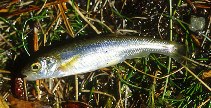| Family: |
Leuciscidae (Minnows), subfamily: Plagopterinae |
| Max. size: |
23 cm TL (male/unsexed); max. reported age: 5 years |
| Environment: |
demersal; freshwater; pH range: 6.5 - 7.80000019073486, non-migratory |
| Distribution: |
North America: Alaska (Yukon River drainage); throughout most of Canada and northern USA; south to Delaware River in New York, south end of Lake Michigan, Illinois, Platte River system in Colorado, and Columbia River drainage in Washington, USA. Relict population in Mississippi River basin in Iowa, USA. Sometimes hybridizes with Rhinichthys cataractae in Lake Superior (Ref. 4564). |
| Diagnosis: |
Dorsal spines (total): 0-0; Dorsal soft rays (total): 8-8; Anal spines: 0-0; Anal soft rays: 7-9; Vertebrae: 39-44. Couesius plumbeus is distinguished by having the following characters: barbel at corner of large, barely subterminal mouth; moderately pointed snout; large eye; head flattened above and below; dorsal fin origin over or slightly behind pelvic fin origin; complete lateral line, 53-70 lateral scales; 8 anal rays, and pharyngeal teeth 2,4-4,2 (Ref. 86798). Spineless fins, normal jaws, and tiny barbel at the corner of the mouth (Ref. 27547). Body moderately compressed and slender, coloration include brown to green above, dark stripe along silver gray side, darkest on young and large male, sometimes black specks on side and belly, dusky caudal spot. Large male may have red at pectoral and pelvic fin origins, corners of mouth (Ref. 86797). In some populations, breeding males develop bright orange-red patches on sides of head and at bases of pectoral fins, but the presence of this color varies from place to place (Ref. 27547). |
| Biology: |
Inhabits virtually any body of water, standing or flowing, large or small (Ref. 5723, 86798). Common in gravel-bottomed pools and runs of streams and along rocky lake margins (Ref. 86798). Mostly found in shallow water, but may move to deeper parts of lakes during hot weather (Ref. 27547). Feeds on zooplankton, algae, terrestrial and aquatic insects, and small fishes (Ref. 1998). |
| IUCN Red List Status: |
Least Concern (LC); Date assessed: 11 November 2011 Ref. (130435)
|
| Threat to humans: |
harmless |
Source and more info: www.fishbase.org. For personal, classroom, and other internal use only. Not for publication.
